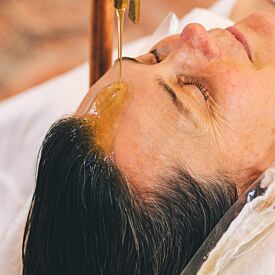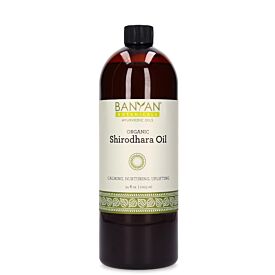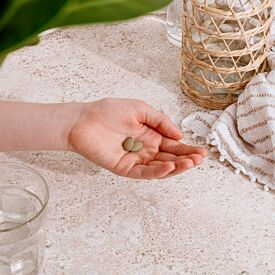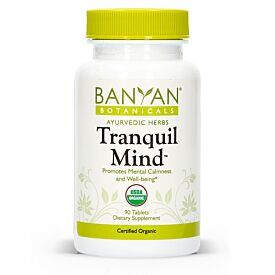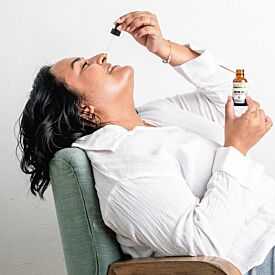Bliss Through Shirodhara
When I first heard about how shirodhara can induce maximum relaxation when I was just a budding Ayurvedic student, I skeptically thought to myself, “Who wouldn’t find warm oil slowly being poured onto their forehead relaxing?” But what seemed to me at the time as simply a luxurious pampering has amazed me both in its broadness in application as well as the beauty behind the mechanism of how it works.
What It Is
For those who are not so familiar with shirodhara, it is a therapy wherein a liquid substance, usually a warm oil or herbal oil, is slowly and steadily poured onto the third eye and then allowed to percolate through the hair. The name itself comes from the Sanskrit words shiro (head) and dhara (flow).
Shirodhara falls into the category of snehana of the shodhana (purifying) therapies in Ayurveda. While snehana means the application of oil, sneha means love and compassion. As such, oil has been glorified in the scriptures for providing the qualities of nurturing and nourishment.1 When the skin absorbs the oil, it also takes in these qualities into the body.
One of the great beauties of shirodhara lies in the fact that the forehead and scalp, of all parts of the body, has greater absorption than any other part of the body, aside from the pubic areas.2 The skin absorbs many substances, including oil, as well as any herb that may be infused into the oil, such that they directly pass through the epidermis and dermis, into the blood stream and tissues that lie beneath. Since the brain and the main sense organs are in such close proximity to the scalp, shirodhara has its greatest and most direct effects there. For this reason, great care is taken to ensure that the highest type and quality of herbs and oils are used in the therapy.
Why It Works
Marmani. A marma is a “vital energy point on the surface of the body.”3 The oil first pours directly onto ajna marma. Synonymous with the third eye, this marma is central to all brain function, hormone glands, and above all, consciousness. The oil then spreads over a number of other marmani. By doing so, we are powering these energetic hot spots with vata and pitta calming qualities through the qualities of the oil and therapy, itself. The qualities access the mano vaha srotas, the channel for the mind and senses, directly through the marmas, sending the same soothing and nurturing qualities throughout the channels.3
Sensory nerves. Not only is the head and face one of the greatest areas of absorption, but they also have the greatest number of sensory nerves. In fact, over half of the sensory cortex in the brain is dedicated to just the face and the head! There are a variety of sensory nerves- some that sense position, some sense temperature and pain, some sense pressure. The interesting connection here is that the pain and temperature nerves, specifically, course through the brain not only to the cortex, but also to the limbic portions of the brain, which are centers for processing emotions and managing conflict, motivation, learning, and attention, amongst other important functions.4 Thus, by stimulating these nerves with anti-vata and anti-pitta qualities, we are bringing those same qualities to the limbic centers of the brain, unfolding a sense of ease and peace to an often disturbed part of our consciousness.
The power of touch. Further, through the somato-autonomic reflex, simply the soft and spreading touch of shirodhara and the subtle vibration throughout the cranial cavity sends an inhibitory signal to the sympathetic nervous system.5 This results in a decrease in heart rate, respiratory rate, blood pressure, and induces an overall sense of calmness and rest.6,7,8 It is no wonder, then, that many clients fall into deep sleep during shirodhara.
A small randomized-controlled study done in Japan studied the above mechanisms amongst others, and proposed the mechanism shown in Figure 1. As demonstrated, numerous pathways have been found, all centering around calming the sympathetic nervous system and balancing the neurochemistry in the brain.6 In plain Ayurvedic language, the therapy calms vata and pitta rooted in mano and majja vaha srotas, thereby affecting the same doshic imbalances in other srotamsi.
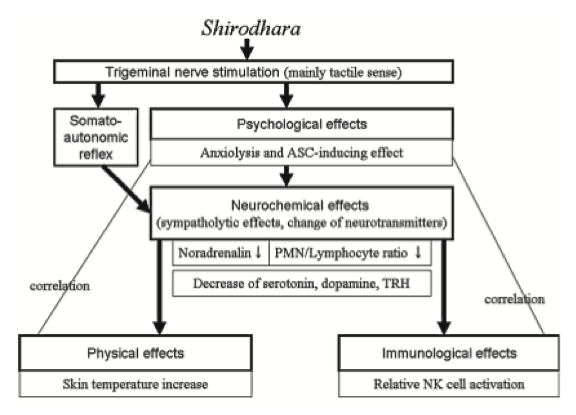
Figure 1. Kazuo U, et al. Psychoneuroimmunologic Effects of Ayurvedic Oil-Dripping Treatment. The Journal of Alternative and Complementary Medicine.
7 Practical Applications
- Marma therapy. The marmani all along the surface of the forehead and scalp get bathed in warm, nourishing oil. The oil, with its viscous quality, provides a protective barrier, so that extreme temperatures, winds, or other environmental influences, have less of an impact on the marmani, thereby protecting our entire mano vaha srotas. Not only that, the marmani on the scalp are all integrally connected to important brain and hormonal centers. By doing marma therapy with constant pressure and nourishment from the oil, these centers are balanced and rejuvenated, making this a therapy beneficial for just about anyone.
- Stress. Enough cannot be said about how our clientele and society, at large, suffers from stress. What shirodhara is able to do is bring softness to the sharpness of stress. By turning the sympathetic nervous system down, cortisol and other stress hormones decrease as do other markers of stress, such as blood pressure and heart rate.6,7,8
- Anxiousness. The prototype of vata in the mano vaha srotas is anxiety. Shirodhara is an excellent way to care for high vata in the mind, as all of its qualities are the opposite of vata. Many experience, for the first time in a long time, that their mind becomes quiet and the unease of anxiousness goes away.6
- Attention and focus. A milder form of vata in the mano vaha srotas is an inability to focus or pay attention. While not as incapacitating as the feeling of anxiety, attention and focus is crucial for day-to-day living. Shirodhara can effectively improve attention by bringing stability to the sensitivity of the neurons in the brain.9
- Sleep. The National Sleep Foundation 2005 survey found that over 75% of Americans have difficulty sleeping at least a few times per week. While there are numerous recommendations ranging from improving sleep hygiene to medications, why not try a therapy that not only can induce more sound sleep10,11, but can also help with the roots of poor sleep discussed above?
- Menopausal symptoms. Many women going through menopause face the same difficulties discussed, in addition to hot flashes and body aches. In India, a small randomized-controlled trial tested shirodhara in menopausal women and found it to be effective for many of their complaints.12 The mechanism likely lies in calming the sympathetic nervous system and neuronal sensitivity.
- Muscle tension and headaches. Muscle tension and dysfunction of neurons cause headaches and pains throughout the body. Interestingly, migraines are thought to arise because of an abnormal response of the neurons in the trigeminal nucleus of the brainstem.13 The forehead’s nerve supply, the trigeminal nerve, is directly connected to this nucleus. It is no surprise, then, that shirodhara can help greatly with headaches and other bodily muscle tension by calming the nerves.
Shirodhara is the king of Ayurvedic therapies for the mind and is a wonderful complement to herbs for achieving optimum mental balance and peace. Watch for our next newsletter with herbal recommendations for supporting the mind.
References
1 Lad, V. Textbook of Ayurveda Volume 3: General Principles of Management and Treatment. The Ayurvedic Press. Albuquerque, New Mexico. 2012
2 Baynes, R and Hodgson E. Textbook of modern toxicology. 3rd edition. John Wiley & Sons, Inc. 2004
3 Lad V, Durve A. Marma Points of Ayurveda. The Ayurvedic Press. Albuquerque, New Mexico. 2008.
4 Spinothalamic tract. Wikipedia. http://en.wikipedia.org/wiki/Spinothalamic_tract. 11 August, 2014.
5 Uchida S, Budgell B. Encyclopedia of Neuroscience. Springer. Berlin, Heidelberg. 2009
6 Kazuo U, et al. Psychoneuroimmunologic Effects of Ayurvedic Oil-Dripping Treatment. The Journal of Alternative and Complementary Medicine. 2008;14(10):1190-98.
7 Kundu C, et al. The role of psychic factors in the pathogenesis of essential hypertension and its management by Shirodhara and Sarpagandha Vati. Ayu. 2010 Oct-Dec; 31(4): 436-441.
8 Dhuri K, et al. Shirodhara: A psycho-physiological profile in healthy volunteers. Journal of Ayurveda & Integrative Medicine. 2013 Jan-Mar; 4(1):40-44.
9 Singhai H, et al. Ayurvedic approach for improving reaction time of attention deficit hyperactivity disorder affected children. Ayu. 2010 Jul-Sep; 31(3): 338-342
10 Pokharel S, Kumar A. Evaluation of Insomrid Tablet and Shirodhara in the management of Anidra (Insomnia). Ayu. 2010 Jan-Mar; 31(1): 40-47.
11 Vinjaymury S, et al. Ayurvedic Therapy (Shirodhara ) for Insomnia: A Case Series. Global Advances in Health and Medicine. 2014 Jan; 3(1): 75-80.
12 Santwani K, et al. An assessment of Manasika Bhavas in menopausal syndrome and its management. Ayu. 2010 Jul-Sep: 31(3);311-318.
13 Dodick D, Gargus J. Why Migraines strike. Scientific American. 2008 Aug: 299(2);56-63.



